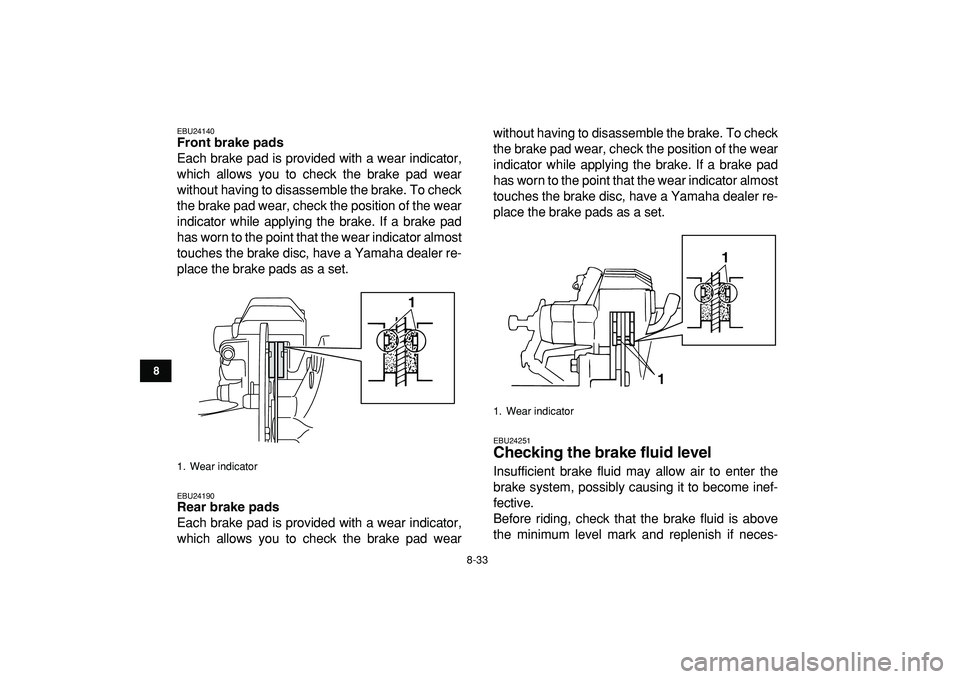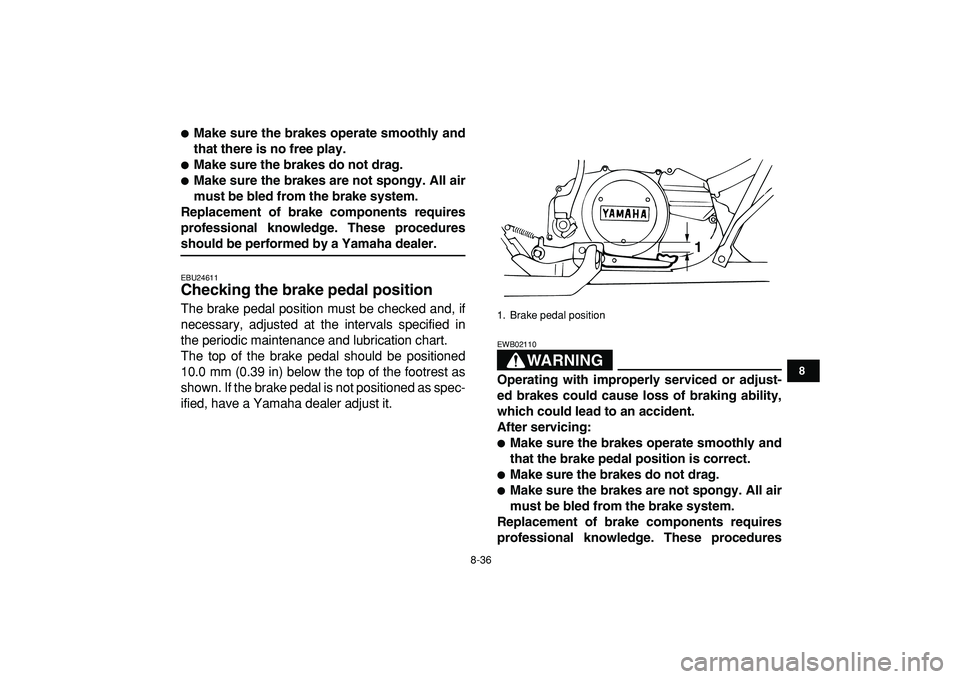Page 75 of 142

7-22
1
2
3
4
5
67
8
9
10
11
to climb:
Turn the ATV around if you still have forward
speed. If not, stop, dismount on the uphill side of
the ATV and physically turn the ATV around. If
the ATV starts to slip backwards, DO NOT USE
THE REAR BRAKE – the ATV may tip over on
top of you. Dismount the ATV on the uphill side.
(See page 7-14.)
�
If your ATV is traversing a sloping surface:
Be sure to ride with your weight positioned to-
wards the uphill side of the ATV to maintain
proper balance. If the ATV starts to tip, steer
down the hill (if there are no obstacles in your
way) to regain balance. If you discover that the
ATV is going to tip over, dismount on the uphill
side. (See page 7-17.)
�
If your ATV encounters shallow water:
Ride slowly and carefully through slow moving
water, watching for obstacles. Be sure to let wa-
ter drain from the ATV and CHECK YOUR
BRAKES FOR PROPER OPERATION when
you come out of the water. Do not continue to
ride your ATV until you have regained adequate
braking ability. (See page 7-18.)
Page 80 of 142

8-5
1
2
3
4
5
6
78
9
10
11
EBU21864
General maintenance and lubrication chart
NO. ITEMCHECK OR MAINTENANCE
JOBINITIAL EVERY
Whichev-
er comes
firstmonth 1 3 6 6 12
km
(mi)320
(200)1300
(800)2500
(1600)2500
(1600)5000
(3200)
hours 20 80 160 160 3201 Air filter element
�
Clean and replace if necessary.Every 20–40 hours (more often in wet or
dusty areas)
2
*
Clutch
�
Check operation and adjust if necessary.
√ √√√
3
*
Front brake
�
Check operation and correct if necessary.
�
Check fluid level and ATV for fluid leakage, and
correct if necessary.
√√√√√
�
Replace brake pads. Whenever worn to the limit
4
*
Rear brake
�
Check operation and correct if necessary.
�
Check brake pedal free play and adjust if neces-
sary.
�
Check fluid level and ATV for fluid leakage, and
correct if necessary.
√√√√√
�
Replace brake pads. Whenever worn to the limit
5
*
Brake hoses
�
Check for cracks or other damage, and replace if
necessary.
√√√√
�
Replace. Every 4 years
6
*
Parking brake
�
Check operation and adjust if necessary.
√√√√√
7
*
Wheels
�
Check runout and for damage, and replace if nec-
essary.
√√√√√
8
*
Tires
�
Check tread depth and for damage, and replace if
necessary.
�
Check air pressure and balance, and correct if
necessary.
√√√√√
Page 82 of 142

8-7
1
2
3
4
5
6
78
9
10
11
EBU23070
TIP
�
The air filter needs more frequent service if you are riding in unusually wet or dusty areas.
�
Hydraulic brake service
�
Regularly check and, if necessary, correct the brake fluid level.
�
Every two years replace the internal components of the brake master cylinders and calipers, and
change the brake fluid.
�
Replace the brake hoses every four years and if cracked or damaged.
19
*
Moving parts and
cables
�
Lubricate.
√√√√
20
*
Throttle lever hous-
ing and cable
�
Check operation and correct if necessary.
�
Check throttle cable free play and adjust if neces-
sary.
�
Lubricate throttle lever housing and cable.
√√√√√
21
*
Front and rear brake
switches
�
Check operation and correct if necessary.
√√√√√
22
*
Lights and switches
�
Check operation and correct if necessary.
�
Adjust headlight beams.
√√√√√
NO. ITEMCHECK OR MAINTENANCE
JOBINITIAL EVERY
Whichev-
er comes
firstmonth 1 3 6 6 12
km
(mi)320
(200)1300
(800)2500
(1600)2500
(1600)5000
(3200)
hours 20 80 160 160 320
Page 107 of 142

8-32
1
2
3
4
5
6
78
9
10
11
optimum engine performance.
TIP
If the specified idling speed cannot be obtained as
described above, have a Yamaha dealer make the
adjustment.
7. Install the seat.
EBU24044
Adjusting the throttle cable free play
The throttle cable free play should be checked
and, if necessary, adjusted at the intervals speci-
fied in the periodic maintenance and lubrication
chart.
The throttle cable free play should measure 4.0–
6.0 mm (0.16–0.24 in) at the throttle lever. Period-
ically check the throttle cable free play and, if nec-
essary, adjust it as follows.
TIP
The engine idling speed must be checked, and ad-
justed if necessary, before adjusting the throttle ca-
ble free play.
1. Loosen the locknut.
2. To increase the throttle cable free play, turn
the throttle cable free play adjusting bolt in di-rection (a). To decrease the throttle cable free
play, turn the adjusting bolt in direction (b).
3. Tighten the locknut.
EBU24130
Checking the front and rear brake pads
The front and rear brake pads must be checked for
wear at the intervals specified in the periodic main-
tenance and lubrication chart.
1. Throttle lever free play adjusting bolt
2. Locknut
3. Throttle cable free play
1
2
3
(a)(b)
Page 108 of 142

8-33
1
2
3
4
5
6
78
9
10
11
EBU24140
Front brake pads
Each brake pad is provided with a wear indicator,
which allows you to check the brake pad wear
without having to disassemble the brake. To check
the brake pad wear, check the position of the wear
indicator while applying the brake. If a brake pad
has worn to the point that the wear indicator almost
touches the brake disc, have a Yamaha dealer re-
place the brake pads as a set.
EBU24190
Rear brake pads
Each brake pad is provided with a wear indicator,
which allows you to check the brake pad wearwithout having to disassemble the brake. To check
the brake pad wear, check the position of the wear
indicator while applying the brake. If a brake pad
has worn to the point that the wear indicator almost
touches the brake disc, have a Yamaha dealer re-
place the brake pads as a set.
EBU24251
Checking the brake fluid level
Insufficient brake fluid may allow air to enter the
brake system, possibly causing it to become inef-
fective.
Before riding, check that the brake fluid is above
the minimum level mark and replenish if neces-
1. Wear indicator
1
1. Wear indicator
11
Page 109 of 142
8-34
1
2
3
4
5
6
78
9
10
11
sary. A low brake fluid level may indicate worn
brake pads and/or brake system leakage. If the
brake fluid level is low, be sure to check the brake
pads for wear and the brake system for leakage.
Front brakeRear brake
Observe these precautions:
�
When checking the fluid level, make sure that
the top of the brake fluid reservoir is level.
�
Use only the recommended quality brake fluid,
otherwise the rubber seals may deteriorate,
causing leakage and poor braking performance.
�
Refill with the same type of brake fluid. Mixing
fluids may result in a harmful chemical reaction
and lead to poor braking performance.
1. Minimum level mark
LOWER
1
1. Minimum level mark
Recommended brake fluid:
DOT 4
LOWER
1
Page 110 of 142

8-35
1
2
3
4
5
6
78
9
10
11
�
Be careful that water does not enter the brake
fluid reservoir when refilling. Water will signifi-
cantly lower the boiling point of the fluid and may
result in vapor lock.
�
Brake fluid may deteriorate painted surfaces or
plastic parts. Always clean up spilled fluid imme-
diately.
�
As the brake pads wear, it is normal for the brake
fluid level to gradually go down. However, if the
brake fluid level goes down suddenly, have a
Yamaha dealer check the cause.
EBU24291
Changing the brake fluid
Have a Yamaha dealer change the brake fluid at
the intervals specified in the TIP after the periodic
maintenance and lubrication chart. In addition,
have the oil seals of the master cylinders and cali-
pers as well as the brake hoses replaced at the in-
tervals listed below or whenever they are damaged
or leaking.
�
Oil seals: Replace every two years.
�
Brake hoses: Replace every four years.
EBU24393
Checking the front brake lever free play
The brake lever free play must be checked at the
intervals specified in the periodic maintenance and
lubrication chart. The brake lever should have no
free play as shown. If there is free play, have a
Yamaha dealer check the brake system.
WARNING
EWB02471
Operating with improperly serviced or adjust-
ed brakes could cause loss of braking ability,
which could lead to an accident.
After servicing:
1. Brake lever free play
1
Page 111 of 142

8-36
1
2
3
4
5
6
78
9
10
11
�
Make sure the brakes operate smoothly and
that there is no free play.
�
Make sure the brakes do not drag.
�
Make sure the brakes are not spongy. All air
must be bled from the brake system.
Replacement of brake components requires
professional knowledge. These procedures
should be performed by a Yamaha dealer.
EBU24611
Checking the brake pedal position
The brake pedal position must be checked and, if
necessary, adjusted at the intervals specified in
the periodic maintenance and lubrication chart.
The top of the brake pedal should be positioned
10.0 mm (0.39 in) below the top of the footrest as
shown. If the brake pedal is not positioned as spec-
ified, have a Yamaha dealer adjust it.WARNING
EWB02110
Operating with improperly serviced or adjust-
ed brakes could cause loss of braking ability,
which could lead to an accident.
After servicing:
�
Make sure the brakes operate smoothly and
that the brake pedal position is correct.
�
Make sure the brakes do not drag.
�
Make sure the brakes are not spongy. All air
must be bled from the brake system.
Replacement of brake components requires
professional knowledge. These procedures
1. Brake pedal position
1